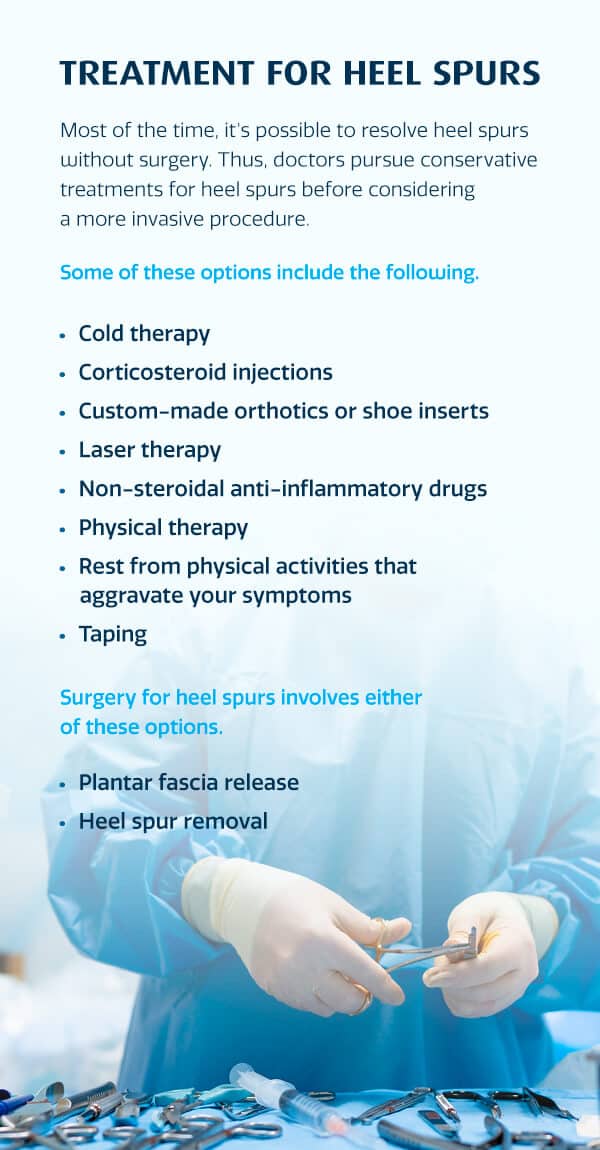A heel spur may sound like the back of a cowboy boot, but the term refers to bony growths that form at the heel. These outgrowths are sometimes painful, but often go unnoticed. To learn more about heel spurs, keep reading this article!

What Is a Heel Spur?
A heel spur is a bone-like growth that protrudes from your heel. This growth consists of calcium deposits that build up over several months. They’re also called calcaneal spurs or osteophytes and can occur underneath or in the back of your heel bone.
Around 15% of the population experiences heel spurs. Such spurs usually extend from underneath the heel toward the arch in the middle of your foot, the plantar fascia tendon. Heel spurs often appear pointy, hooked or spatula-like. Since heel spurs typically grow toward the plantar fascia, they often link to another condition called plantar fasciitis. Plantar fasciitis occurs when the plantar fascia tendon becomes torn or inflamed.
What Causes a Heel Spur?
Heel spurs often occur from prolonged or repetitive stress on your foot muscles and ligaments. When the soft tissues that protect the heel wear out or experience inflammation, calcium deposits form. Calcium deposits, also called calcification, are a regular part of the healing process. The deposits stabilize damaged tissue and protect it from infection. With too much calcification, bone spurs develop.
Any injury or damage to the ligaments, muscles, cartilage or tendons around the heel bone can lead to bone spurs. Because the plantar fascia is the main supporting ligament of the heel, plantar fasciitis is a common cause of heel spurs. Approximately 50% of patients with plantar fasciitis experience heel spurs. Besides the plantar fascia, heel spurs often occur when the membrane covering the heel bone tears from overuse injuries.
Here are some risk factors for overuse injuries that can lead to heel spurs:
- An abnormal walking pattern can place excessive stress on the heel bone and tissues that support it.
- Increasing age, as your supporting heel tissues degenerate over time.
- Running, sprinting or jogging on hard surfaces.
- Trauma to the heel.
- Issues with foot anatomy, such as flat feet or high arches.
- Poorly fitted shoes or shoes with insufficient arch support.
- Excess weight, which puts increased pressure on the heel and its supporting tissues.
- Various medical conditions, such as diabetes or arthritis.
- Frequent and prolonged time spent on your feet.

How to Know If You Have a Heel Spur
Heel spurs often go unnoticed until the pain starts. Thus, they don’t always produce detectable symptoms until they’ve progressed. If you’re living with chronic or intermittent heel pain, you may be dealing with a heel spur. Still, various conditions can cause heel pain, so it pays to know the symptoms of heel spurs, which include:
- Sharp pain in the morning and a dull ache throughout the day.
- Swelling at the front of your heel, where it meets the arch of your foot.
- Warmth radiating around the heel.
- Tenderness at the bottom of the heel, making walking difficult.
These symptoms also apply to other foot conditions, so it’s a good idea to have a doctor examine your heel pain to get appropriately diagnosed.
How Do Doctors Diagnose Heel Spurs?
Medical providers diagnose heel spurs with a physical examination and X-ray imaging. With the physical examination, your doctor will assess the area to see if the spur is visible without an X-ray. They may also perform palpation, which involves gently pressing on the surface to feel the tissues underneath and locate pain centers. As they examine your heel and foot arch, they’ll also ask you various questions about:
- Physical activities that may have caused the foot pain.
- When the pain began and how it feels at different times of the day.
- If specific activities trigger or worsen the pain.
If they have reason to suspect a heel spur, your doctor will likely order an X-ray to confirm a heel spur diagnosis. Most heel spurs will show up under an X-ray scan. If the X-ray does not indicate a suspected heel spur, your doctor may diagnose you with heel spur syndrome — a condition where a patient exhibits heel spur symptoms without visible evidence of a spur.

Treatment for Heel Spurs
Most of the time, it’s possible to resolve heel spurs without surgery. Thus, doctors pursue conservative treatments for heel spurs before considering a more invasive procedure. Some of these options include the following.
- Cold therapy: Applying ice to the affected area can reduce swelling and pain.
- Corticosteroid injections: Corticosteroid injections also reduce inflammation around heel spurs and damaged tissue.
- Custom-made orthotics or shoe inserts: Doughnut-shaped inserts for your shoe support and relieve pressure on the heel.
- Non-steroidal anti-inflammatory drugs: NSAIDs include ibuprofen, aspirin and naproxen. These medications relieve pain by reducing inflammation.
- Physical therapy: Physical therapy involves stretching and other exercises to restore strength and function to your heel and reduce pain.
- Rest from physical activities that aggravate your symptoms: You may need to take an extended break from such activities until the heel spur improves or take frequent rest breaks.
- Taping: Applying tape around the heel can support overstressed tissues around the heel spur.
Surgery for heel spurs involves either of these options.
- Plantar fascia release: The surgeon releases part of the plantar fascia from the heel bone to relieve tension and inflammation. It’s possible to perform this surgery endoscopically, using a small, flexible tube with a tiny camera attached. This camera allows the surgeon to perform surgery without large incisions, making it minimally invasive. As a minimally invasive procedure, endoscopic surgeries involve less damage to surrounding tissues and shorter recovery times than traditional surgery.
- Heel spur removal: The surgeon makes multiple small incisions and removes or detaches the calcium deposit using surgical tools. It’s also possible for a surgeon to do heel spur removal endoscopically.
FAQs About Heel Spurs
Heel spurs are a common foot condition, but patients often have several questions about them. In that light, here are some answers to frequently asked questions about heel spurs.
Is Walking Good for Heel Spurs?
Some say walking can help with heel spurs, while others recommend taking it easy. If you include walking in your exercise regimen, rest your heel whenever you feel significant pain and inflammation. You should also ensure your shoes provide adequate support to your foot’s arch and consider inserts that relieve heel pressure.
How Long Does a Heel Spur Last?
Once a heel spur forms, it remains there unless a doctor surgically removes it. However, since heel spurs can be asymptomatic, surgery isn’t always necessary. The goal of heel spur treatment is to manage your symptoms rather than spur removal. Surgical removal is sometimes the only way to alleviate heel spur pain. Still, conservative treatments typically bring adequate symptom relief.
How Big Can Heel Spurs Get?
According to the American Podiatric Medical Association, heel spurs can extend as far as half an inch from the heel. Spurs of that size are likely to cause significant pain, but most spurs are much smaller.
What Happens If a Heel Spur Goes Untreated?
If a heel spur is not causing you any symptoms, it’s OK to let it go untreated. You may not even know it is there. If the spur causes discomfort, leaving it untreated can worsen the pain to the point where it’s impossible to bear weight on the affected foot. In these circumstances, surgery usually becomes necessary. Thus, it’s essential to seek treatment early on if a heel spur is causing you pain to avoid surgery.

Seek Heel Spur Relief With Foot & Ankle Surgical Associates
If you’re dealing with heel pain and suspect you might have heel spurs, we’d be happy to take a closer look at Foot & Ankle Surgical Associates! Our skilled, board-certified podiatrists have experience in treating all foot-related conditions. We also pride ourselves in seeking the least invasive treatment options for our patients in all circumstances — pursuing surgery only as a last resort. For more information about our heel spur treatment options or to schedule an appointment, call us at 360-754-3338.




